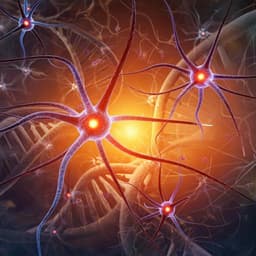
Medicine and Health
Pharmacological targeting of MCL-1 promotes mitophagy and improves disease pathologies in an Alzheimer's disease mouse model
X. Cen, Y. Chen, et al.
This groundbreaking study reveals the therapeutic potential of UMI-77, a drug that activates neuronal mitophagy, targeting MCL-1 as a receptor. Conducted by Xufeng Cen and colleagues, it shows promise for reversing Alzheimer’s disease symptoms through potent mitophagy activation. A game-changer in Alzheimer's treatment!
~3 min • Beginner • English
Introduction
Alzheimer’s disease (AD) is characterized by memory loss and cognitive dysfunction. Mitochondrial dysfunction is an early and fundamental hallmark in AD, preceding amyloid-β (Aβ) deposition and exacerbating both Aβ and hyper-phosphorylated Tau (pTau) pathologies. Defective mitochondrial biogenesis, impaired calcium homeostasis, and increased ROS contribute to synaptic dysfunction and neuronal death. Given that mitochondrial dysfunction can accelerate Aβ production and that suppressing mitochondrial function worsens Aβ pathology, enhancing mitochondrial quality control is a promising therapeutic strategy. Mitophagy—the selective autophagic removal of damaged mitochondria—is impaired in AD, and boosting mitophagy reduces Aβ plaques, Tau tangles, and improves cognition in models. Mitophagy receptors recruit LC3 family proteins via LIR motifs to drive mitochondrial engulfment. This study sought to identify druggable mechanisms to safely induce mitophagy and test whether targeting MCL-1 with the BH3-mimetic UMI-77 could promote mitophagy and ameliorate AD phenotypes.
Literature Review
Prior work shows mitochondrial dysfunction precedes Aβ accumulation in AD models and is linked to increased Aβ and pTau, synaptic deficits, and neuronal loss. Enhancing mitophagy reduces Aβ and Tau and improves memory in AD models. Canonical and receptor-mediated mitophagy pathways involve ubiquitin-dependent mechanisms (PINK1/Parkin) and ubiquitin-independent receptors (e.g., OPTN, p62/SQSTM1, NDP52, NBR1, NIX/BNIP3L, FUNDC1, AMBRA1, Bcl-2-L-13, PHB2), which engage LC3/GABARAP proteins via LIR motifs. Some Bcl-2 family proteins regulate mitophagy, including inhibitory interactions with Parkin. Existing mitophagy inducers like CCCP/oligomycin A are cytotoxic; safer agents like nicotinamide riboside and urolithin A show promise. MCL-1 has been implicated in mitochondrial dynamics and autophagy; reports suggest it can suppress AMBRA1-mediated mitophagy under depolarization, whereas its broader role in ubiquitin-independent mitophagy remained to be defined.
Methodology
- High-throughput screen: A library of 2024 FDA-approved drugs/candidates (Topscience) was screened in HEK293T cells stably expressing mt-Keima, a ratiometric mitophagy reporter. Imaging used Biotek Cytation 3 (excitation 469/586 nm, emission 620 nm). Compounds with >1.5-fold increase over DMSO were hits. PBS served as positive control; DMSO negative. Z factor > 0.5.
- Cell lines and culture: HEK293T, HeLa, SH-SY5Y, U2OS, MEF WT and ATG5−/−, HeLa WT and quadruple KO (NBR1, TAX1BP1, p62, NDP52), HEK293T/SH-SY5Y with stable MCL-1 knockdown, doxycycline-inducible MCL-1-overexpressing HEK293T (HEK293T-MF2). Standard DMEM with 10% FBS, 1% pen/strep at 37°C, 5% CO2.
- Mitophagy and organelle assays: mt-Keima excitation shift quantified; LysoTracker colocalization with mitochondria; mitochondrial membrane potential with JC-1 after UMI-77 (5 µM, 12 h) or CCCP (10 µM). Transmission electron microscopy (TEM) for mitophagosome structures.
- Protein analysis: Western blot of mitochondrial markers (Tom20, Tim23), ER (calnexin), cytosolic (tubulin), autophagy markers (LC3, p62). Lysosomal inhibition (E64D, NH4Cl/leupeptin) and proteasome inhibition (MG-132) to define degradation pathways. Autophagic flux assessed via LC3-II changes.
- Genetic perturbations: siRNA/shRNA knockdown of MCL-1, ATG5, Beclin1, Bax, FUNDC1, BNIP3, NIX; HeLa quadruple KO for NBR1, TAX1BP1, p62, NDP52; MEF ATG5−/−; rescue with MCL-1 WT and mutants. Doxycycline-inducible MCL-1 overexpression for gain-of-function.
- MCL-1–LC3 interaction studies: Identification of two C-terminal LIR motifs (LIR261–264 and LIR318–321). Generation of LIR mutants (W261A, I264A, W261A/I264A, ΔLIR261–264, F318A, V321A, F318A/V321A) and Bax-binding deficient MCL-1-M (L213A/D218A). Co-immunoprecipitation (Flag/HA) to test interactions with LC3A and other Atg8 family members; GST pull-down with purified proteins to assess direct binding. Duolink proximity ligation assay (PLA) for endogenous MCL-1–LC3A interaction in situ, including in HeLa WT and receptor quadruple KO cells.
- Physiological stress model: Oxygen-glucose deprivation (OGD) to induce mitochondrial damage; assess mt-Keima shift, mitochondrial morphology (HSP60 staining), and MCL-1 dependency. Examine effect of LIR261–264 mutations on OGD-induced mitophagy versus mitochondrial fragmentation.
- In vivo studies: mt-Keima transgenic mice injected i.p. with UMI-77 (10 mg/kg); hippocampal mt-Keima signal measured at 6 h. APP/PS1 mice treated i.p. with UMI-77 (10 mg/kg) every other day from 4 months of age for 4 months; behavioral testing with Morris water maze (escape latency over 4 days; probe trial platform crossings). Biochemical analyses: ELISA for soluble/insoluble Aβ1–42; cytokines TNFα, IL-6, IL-10 from whole-brain lysates. Histology: IHC for Aβ plaques (6E10), astrocyte activation (GFAP), DAPI; EM for hippocampal mitochondrial morphology. AAV-mediated hippocampal overexpression of MCL-1 in WT and APP/PS1 mice; Morris water maze and plaque assessment after 30 days.
- Statistics: Two-tailed t tests or one-way ANOVA; data presented as mean ± S.E.M.; sample sizes indicated per figure. Experiments repeated at least three times for consistency.
- Reagents: UMI-77, MG-132, bafilomycin A1, leupeptin, E64D, doxycycline, NH4Cl; antibody panels for markers and tags; IP beads (anti-Flag, anti-HA).
Key Findings
- Screening identified UMI-77, an MCL-1–specific BH3-mimetic, as a robust mitophagy activator. At 5 µM (sub-lethal), UMI-77 did not depolarize mitochondria (JC-1) in HEK293T or HeLa cells compared with CCCP (10 µM), yet significantly increased mitophagy; co-treatment with CCCP further augmented mitophagy.
- UMI-77-induced mitophagy is apoptosis-independent: pan-caspase inhibitor Z-VAD-fmk did not block mt-Keima excitation shift; UMI-77 induced mitophagy strongly without inducing apoptosis at sub-lethal doses.
- UMI-77 increased mitochondria–lysosome colocalization and TEM showed mitochondria within autophagosomes. Mitochondrial proteins Tom20 and Tim23 were degraded over time across multiple cell types; degradation was blocked by lysosomal inhibitors (E64D, NH4Cl/leupeptin) but not by MG-132, indicating lysosome-dependent mitophagy. Non-mitochondrial markers (calnexin, tubulin) and p62 did not decrease, supporting selectivity for mitophagy over macroautophagy.
- MCL-1 is required and sufficient for mitophagy: MCL-1 knockdown prevented UMI-77-induced Tom20/Tim23 degradation and mt-Keima shift. Doxycycline-induced MCL-1 overexpression decreased mitochondrial markers, increased mitochondria–lysosome colocalization, produced smaller fragmented mitochondria, and TEM confirmed mitophagy.
- Mechanism: MCL-1 harbors two C-terminal LIR motifs; LIR261–264 is conserved and cytosolic. UMI-77 enhanced MCL-1–LC3A interaction while reducing MCL-1–Bax binding. MCL-1 also interacted with other Atg8 family proteins upon UMI-77. Mutations in LIR261–264 (W261A, I264A, W261A/I264A, ΔLIR261–264) attenuated MCL-1–LC3A binding, whereas LIR318–321 mutations did not. GST pull-down showed direct MCL-1–LC3A binding. PLA demonstrated increased endogenous MCL-1–LC3A interactions on mitochondria with UMI-77. In MCL-1–knockdown cells, UMI-77-induced mitophagy was rescued by MCL-1 WT but not by LIR261–264 mutants; LIR318–321 mutation did not impair rescue.
- Pathway specificity: UMI-77-induced mitophagy occurred in HeLa cells lacking NBR1, TAX1BP1, p62, and NDP52, and did not require FUNDC1, BNIP3, or NIX. Mitophagy required ATG5 (blocked by ATG5 knockdown or in ATG5−/− MEFs) but was Beclin1-independent. Parkin was not required (HeLa cells with undetectable Parkin still responded). Bax knockdown enhanced UMI-77-induced mitophagy.
- Physiological relevance: OGD induced mitophagy and mitochondrial fragmentation; MCL-1 knockdown blocked OGD-induced mitophagy (mt-Keima shift and Cox II/Tim23 degradation) and rescued fragmentation. OGD increased MCL-1–LC3A interaction and decreased MCL-1–Bax interaction. LIR261–264 mutants did not affect fragmentation but significantly blocked OGD-induced mitophagy, indicating distinct MCL-1 roles.
- In vivo efficacy: In mt-Keima mice, i.p. UMI-77 (10 mg/kg) increased hippocampal mt-Keima signal at 6 h (p=0.0083). In APP/PS1 mice treated every other day for 4 months, UMI-77 improved cognition: increased platform crossings in probe trial (p=0.0053) and reduced escape latency over training (p=0.0334). Insoluble Aβ1–42 levels were reduced (p=0.0463); IHC showed smaller hippocampal Aβ plaques and reduced GFAP staining. Pro-inflammatory cytokines TNFα and IL-6 decreased, IL-10 unchanged. EM revealed restored mitochondrial morphology in neurons.
- AAV-mediated hippocampal MCL-1 overexpression ameliorated cognitive decline and reduced hippocampal Aβ plaques in APP/PS1 mice; it also improved learning in WT mice, underscoring MCL-1’s neuronal role.
Discussion
The study addresses whether pharmacologically targeting MCL-1 can induce mitophagy and ameliorate AD-related pathology. Findings establish MCL-1 as a bona fide mitophagy receptor that directly binds LC3A via a critical LIR261–264 motif, promoting mitophagosome formation without causing mitochondrial depolarization or apoptosis. UMI-77 enhances the MCL-1–LC3A interaction while releasing MCL-1 from Bax, shifting MCL-1’s function toward mitophagy. UMI-77-driven mitophagy operates via an ATG5-dependent, ubiquitin-independent pathway and is independent of Parkin and several adapter receptors (NBR1, TAX1BP1, p62, NDP52) as well as FUNDC1/BNIP3/NIX. Physiologically, MCL-1 is necessary for OGD-induced mitophagy, with its LIR261–264 motif required for mitophagy but dispensable for mitochondrial fragmentation, indicating separable mechanisms. In vivo, UMI-77 induced mitophagy in brain and improved cognition, reduced Aβ burden, neuroinflammation, and mitochondrial abnormalities in APP/PS1 mice; MCL-1 overexpression phenocopied these effects. These results support mitophagy induction as a therapeutic strategy for AD and nominate MCL-1 as a druggable receptor for selective mitophagy enhancement.
Conclusion
This work identifies MCL-1 as an LC3-interacting mitophagy receptor that mediates selective mitochondrial clearance via its LIR261–264 motif, distinct from its role in mitochondrial fragmentation. The MCL-1 BH3-mimetic UMI-77 potently induces mitophagy without triggering apoptosis or mitochondrial depolarization, functioning through an ATG5-dependent, Parkin- and adapter-independent pathway. In vivo, UMI-77 enhances neuronal mitophagy and significantly improves cognitive and pathological endpoints in APP/PS1 mice, while AAV-mediated MCL-1 overexpression yields similar benefits. These findings highlight MCL-1 as a therapeutic target for AD and support mitophagy induction as a viable disease-modifying strategy. Future work could optimize MCL-1–targeting compounds for CNS delivery and safety, delineate potential cooperation with other mitophagy receptors, and evaluate efficacy across additional neurodegenerative models.
Limitations
Related Publications
Explore these studies to deepen your understanding of the subject.







